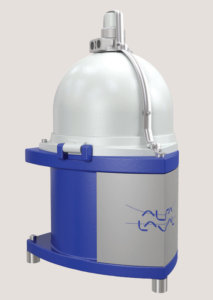Alfa Laval MIB 503
Introduction
MIB 503 is one of the smallest separators of Alfa Laval’s solid bowl series. This product has been an upgrade of its predecessor, MIB 303, and has been developed to fulfill all requirements of the marine and diesel industry.
Application
This product has been designed for the removal of particles and water from distillate, marine diesel and lubricating oils. Removal of water and particles from mineral oil improves the reliability of the oil system. It also prevents serious wear and damages to the main engine.
Benefits
- Easy to install and start up
- Easy to operate and maintain
- High separation efficiency
- Robust and reliable design
- Lightweight materials
- Small footprint
Design
The separator consists of the frame housing, the separatorbowl, the inlet and outlet device as well as the electric motor. The frame housing is the part where the electric motor and the bowl are fitted. The motor can easily be accessed and inspected from a hatch. The hatch is located on the front part of the housing. The complete frame is sitting on rubber dampers which absorb all vibrations during operation. The separator consists of a solids-retaining bowl which, depending on the application, can be used both as purifier or clarifier.
The MIB 503 is one extremely lightweight design. The outer parts of the bowl are manufactured in surface-coated aluminium and most of the inner parts i.e. the disc stack, the bottom disc and the inlet cone are manufactured in highgrade polymer composite. The unique drive technology is based on an electric motor mounted directly to the bowl compared to conventional design of gear and belt systems.
Scope of supply
- Frame housing
- Separator bowl
- Inlet & outlet device
- Electric motor, direct driven
- Set of plates
- Documentation
Options
- Bowl conversion kit
- Service kits
- Set of tools
Working principle
The purifier operation takes place in the rotating solid-wall bowl. When the bowl is set as a purifier the uncleaned oil is fed into the bowl where the centrifugal force makes water and solid particles move out towards the periphery of the bowl, while the clean oil flows inwards.
To establish a water seal during start-up of the separator, water is added to the bowl before the oil feed is started. The water collects in the water seal which drains into the water channel below the bowl.
The solids accumulate on the bowl wall and are removed periodically by hand. The cleaned oil flows towards the centre of the bowl and up to the paring disc. Since the oil is rotating, the stationary paring disc acts as a pump which forces the oil out through the outlet under pressure.
During the clarifier operation, the oil normally does not contain any free water. The separation principle is similar to the purifier, however there is no water seal, no water outlet and the water handling capacity is limited.
Technical data
Performance data
| Gas oil (1,5 – 6 cSt/40°C) | Max. 1250/1000 l/h — Clarifier/Purifier |
| Marine diesel oil (13 cSt/40°C) | Max. 1000 l/h |
| Lube oil | Max. 300 l/h |
| Power consumption separator and pump | Max. 0.7 kW (0.93 HP) |
| EHM power | 7/14kW — LO/MGO-MDO |
| Feed temperature | Max. 95°C |
| Heating media | Hot water / electricity |
Connections
| Feed inlet | G 3/4 inch |
| Clean oil outlet | G 1/2 inch |
| Drain | G 1/2 inch |
| Heating media inlet | G 3/4 inch |
| Heating media outlet | G 3/4 inch |
Material data
| Separator frame | Surface coated aluminum |
| Separator bowl | Surface coated aluminum. High-grade polymer composite |
| Module frame | Structural steel |
| Gaskets and O-rings | Fluorocarbon rubber (Viton®) |
Weights
| Gas oil module (net/gross) | 68/98 kg (150/216 lbs) |
| CBM module (net/gross) | 82/114 kg (181/251 lbs) |
| EHM module net/gross | 95/130 kg (209/287 lbs) |
